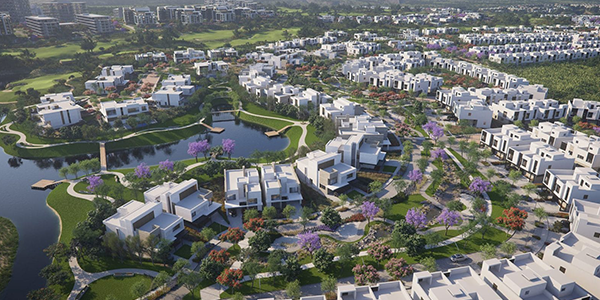
By Engr. Mohammad Iqbal Mirza, CEO, Green Leaves
The primitive man found caves as shelters to withstand extreme cold and heat. Although the houses today we all live in are very comfortable as compared to caves, but the level of comfort is not restricted to a strong roof, walls, cooking, eating and sleeping place isolated by a boundary wall, but it should depict beauty both inside and outside providing deep intimacy with nature. Unfortunately our houses are mere a resting place where there is stalemate and only stalemate clinging deep with its interior and exterior.
Human being has survived through all the hardships and scarcity of immediate “basic needs” the food (including water), shelter and clothing. Even today these immediate basic needs are out of reach for majority of people in the world according to WHO laid down standard. Although today few other things have made their way into the list of basic needs such as, education, health care, protection and security, yet the most acute concern of a society or the incumbent government is to provide housing to homeless people at one hand and not allowing slums to develop around the cities where every lacking is present right from basic amenities of life to highly unhygienic living conditions contributing to growing immorality all around the world.
I was a resident of Lahore walled city, in there were hardly flush toilets, which today determine the sanitation and hygiene level of housing colonies. The filth depot were located within the residential areas. If we do away with the rich culture, magical profile of its wonderful inhabitants living traits of walled city, the houses space and their designs had poor sun light ingress and ventilation. The narrow winding streets of Lahore and its architecture depicts the inner capacity of those who designed it. On one hand if we witness the grandeur of Mughal architecture in the Shalimar gardens, the Lahore Fort or popularly known as Shahi Qila and Masjid Wazeer Khan, etc. on the other hand the most of Lahore walled city houses with all their magical façade were a starkly suffocating-dark living places-low roofs, with only one side open.
The affluent had a much better living conditions in the walled city as compared to common people a hundred years ago, but unfortunately the living conditions haven’t changed for common man in Pakistan even in the twenty first century. Today, the world has changed and is in a process of continuous change. The new housing schemes are no different than the town planning and houses built 500 years or a hundred years ago.
My worry is not what happened in the past, but what is happening at the present. The modern housing schemes being developed today especially for middles class families are of 3, 5, 7, 10, and 12 Marla or one Kanal. The plots are rectangular having width proportions of 25’ by 45’. 35’ by 65’, 50’ by 90’ and so on. The developers have least bothered which way the plots should be orientated, one can find plots orientated in all directions without considering enough of sun, wind and light reaching in the houses. The roofs are getting lower and lower, the outer walls which were used to be 20-30 inches thick in old Lahore have been squeezed to 13 inches now, and the buildings are placed close to each other due to which they are shading each other from three sides while front is left open to the sun. As a result poor ventilation, inadequate sunlight, hot in the summer and cold in the winter is the hallmark of our modern housings. I do not find today’s houses any different from shelters, the primitive man used to live in except the presence of household appliances of modern technology.
The house for a lower and middle class is a life time investment, it should bear a strength that shall withstand natural calamities and provide comfort to its inhabitants. What all of us know very well is that cooling comfort in the summer and heating in the winter incurs lot of cost besides an initial investment of buying the air-conditioning system, which every one cannot afford. Insulation techniques of building cavity walls or using polyurethane foam is available these days, but it is an additional cost and the general information what I have at least; and it is also in my personal experience that it has yielded poor results. May be the Companies selling insulation material are offering sub-standard material or of lesser thickness which cannot stop the ingress of heat, but if the architects, town planners and housing scheme developers use nature in their designing and planning along with modern material the life could be much comfortable in the houses. Presently people rely on air-conditioning and gas heaters for comfort in summer and winter respectively, but frequent power outages render the environment unbearable inside the houses.
Every house built throughout Urban Pakistanis is an independent unit having a predefined mandatory open space on all or at least three sides of the 10 Marla and one Kanal houses with a boundary wall surrounding it; and houses of lesser dimensions are sandwiched with adjacent house from one corner of the street to the other with no functional space at the back or front. The living area and bed rooms or drawing and dinning in smaller dimension houses paint a picture of prisoner cells. The owners desperately want to have enough functional space inside, because of large family sizes. There is no way to profusely connect with nature. The streets at the front are so narrow that hardly one car of medium size can drive through. Over and above the by-laws violation by the house owners make the houses ambience not only funny, but also ugly because of the varying heights of ramps. These modern house lack in the attributes of deep comfort, beauty and purpose also.
Houses in Pakistan are energy centric and the prevailing power shortage in the country renders them unfit to live without it. The architects are designing beautiful houses, but one cannot find regional culture in these designs. If we look at the interior of houses, they depict an old banal image devoid of any geometrical fineness. What can happen? Our coming generations will never know the style of their ancestors dwelling. It is very important that our generations remain connected with our history. I believe every comfort can be created in the living quarters our forefathers used to dwell. Though modern designs do spice the lives of inmates with good intimacy, but it deprives them of any connection with nature and outside world. The absence of traditional residential architecture need to be incorporated in the modern design.
The subcontinent architecture is rich in geometrical beauty and proportional division of space can be seen in Gandhara and indus valley, but it is absent in today’s town planning. The focus is more use of space to extract as many number of housing units as possible. We do not experience any spatial polarity even in farm houses, a common scene in old Lahore havelies. What our architects need to do is to design houses with zero energy demand and create a comfortable environment for its dwellers. Water, plants and animals bring nature into the house and connect with all the human senses, but we find anything like this in newly designed housing schemes and housing units. (To be continued)






